"OFT-IMITATED
AND NEVER EQUALED"
by

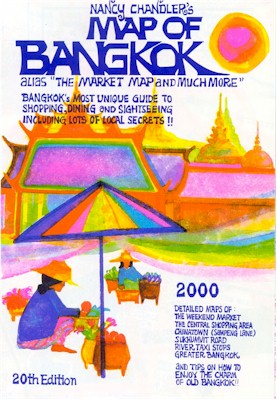
|
Or so
says Joe Cummings and the folks at Lonely Planet in describing
Nancy Chandler’s colorful maps. If you’ve been in Thailand
for any length of time, you must have seen them. But, what’s the story
behind this beautiful cartography and how the designer
ended in Bangkok?
Nancy
and her ex-husband Al Chandler met in 1957 while doing undergrads at U-Cal
Berkeley, Nancy was
studying
art history and Al mining engineering before he moved on to Harvard to study law
after two years in the
US Navy
(Today, Al is one of the few farangs with a lifetime license to provide legal
services in Thailand).
|
A number
of Al’s classmates in law school had found work through an Asia-Africa Fellowship
program, sponsored by the Ford Foundation and administered by Syracuse
University. It sent them to Africa where they filled positions of
former British expatriates e.g. supervising court systems, managing game parks,
teaching etc. They kept sending back postcards, which encouraged
the Chandlers to sign up for the program as well. The Chandlers were to
be sent to Lahore, Pakistan, but as luck would have it, an opening arose
in Kathmandu with the Nepalese Bureau of Mines and that’s where they
ended up in 1966.
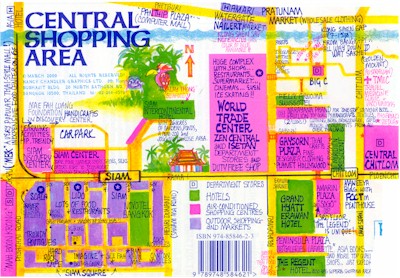
On the
way to Nepal, all of Nancy’s art supplies mysteriously disappeared, so she had
to turn to the local markets
for
supplies. This is where she discovered the bright hues of puja powder, which is
used for tica markings, and also
where
she developed an interest in handmade paper. It’s also how she picked up her
love for bright colors. Just
before
Al’s tenure with the Fellowship was up, Nancy discovered she was pregnant, and
the couple decided that
Nancy
should stay and give birth to their first daughter, Nima (which means Sunday in
the Sherpa language) in
Kathmandu.
She did and since the couple needed money, Nancy started to sell her sketches of
Nepalese
characters
and the Himalayan scenery to expatriates and in hotels and shops in Kathmandu.
The
Chandlers decided to leave Nepal in February of 1968 and traveled via Delhi to
visit friends and game parks in
Kenya,
Tanzania and Uganda. After that, they made their way stateside via Asia,
including stops in Thailand,
Cambodia,
Indonesia, Hong Kong and Japan. Upon returning to the US three months later,
they lived in
Washington
for one year. After a while they started toying with the idea of moving to San
Francisco. Then one of Al
Chandler’s
law school classmates called to tell him that Kirkwood & Associates, a small
law firm with a branch in
Saigon,
was looking for a lawyer for their growing Bangkok office.
They
arrived here in June of 1969, and Nancy soon found mostly volunteer work for
a number of publications including Sawaddi, the American Women’s
Club magazine (not Thai International's Sawasdee), Living in Thailand
and the Bangkok World. She jokes that she was "sketching illustrations
to meet the Sawaddi deadline between contractions of her second daughter,
Siri."
|
In May
of 1974, Nancy Chandler Graphics was born and the first edition of Nancy
Chandler's Map of Bangkok was published. Then in 1981, Nancy Chandler's Map of
Chiang Mai followed, both inspired by illustrations originally commissioned by
Sawaddi. The summer of 1987,
Nancy moved back to Mill Valley, California where she established a sister
company to distribute maps to wholesalers in the US, sell handmade saa paper to
artists in the local community, and offer a variety of graphic design services.
But want about the maps themselves, how did they come about?
Nancy says, "I never even thought of doing a map
of
Bangkok until the editor of Sawaddi asked me back in 1974 to simply redraw a
tiny old map (about 3" x 4")
pinpointing
the markets in Bangkok. It was to accompany an article being updated and revised
about ‘The Markets
of
Bangkok.’ The magazine was produced completely by volunteers and I was one of
their illustrators. I had only
been in
Thailand for a few years and hadn't explored much as I had been very busy with
my two tiny daughters.
|
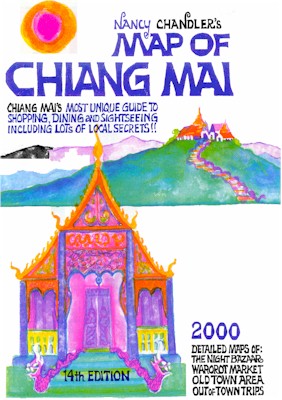 |
Once I
started to explore Chinatown with the two women working on the article, I began
to get very excited by all
the
things one could buy down there as well as the temples and the little noodle
shops for refreshments, which we
went to
when the ‘research’ became too tiring and we needed a break. I thought we
should perhaps expand the
original
map a bit and add a detail of Chinatown.
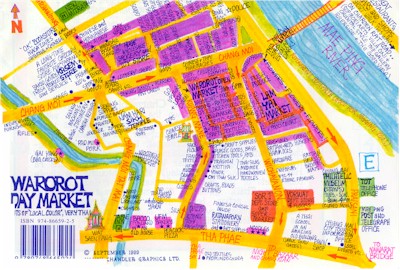
"Then
we moved on to ‘research’ the Weekend Market, held at Sanam Luang in those
days. Again, I found it to be
so
colorful and full of many Thai textiles, handicrafts, hardware, produce, food,
etc. There seemed to be no logical
organization
to the layout of the market. When I suggested expanding our map of that area
into a larger detail, we
did
attempt to give some kind of order to the overall picture. Soon the tiny map
became the centerfold of that
May-June
1974 issue --much more than just dots to show where the markets were. I was not
trained as a
cartographer
but simply looked at several basic maps and took the best bits from each as
there didn't seem to be
any one
really accurate map."
So how
long did it take to get off the ground?
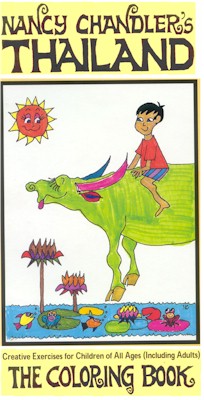
|
"That first map was done in about a
month, because of the magazine's
deadline,
but I didn't even know how to prepare the artwork properly in 1974. I didn't
know you should separate the
line
artwork (the lettering) from the half tones (the drawings and colors). My
letters came out quite blurry as they
too
were broken up into the ‘dot pattern.’ There were many blank spaces on that
first map. By 1976, or so, I had
had
enough feedback from the farangs in the community to learn they really liked the
idea of the map. I switched to
another
printer and began to publish it on my own. I learned how to prepare the artwork
more professionally from
that
printer and I am still using him to this day. During the first few years, I
didn't revise it annually- partly because
there
were not that many changes going on but now, we do revise it every year. It is
in the twentieth edition for this
year,
2000 and there is hardly a blank space on the entire map because it is so much
more full of information. It has
been
fascinating to watch the changes in Bangkok during these twenty-six years."
|
Nima
Chandler, now runs the family business. She took over the company in 1997, but
only if her mother would let
her run
the show. Does Nima have any plans for any new maps? "I was interested in
doing Phuket," she says,
"until
I helped my mother update the Chiang Mai map and found out how long it
took," she says. "We update
every
year, but it takes a full two months just on research, and we can’t afford to
hire someone to do it full-time.
We also
don’t want to dilute the product, we think we have exceptional maps of Bangkok
and Chiang Mai and we
do the
best research we can. We have had people who have asked to do ‘Nancy style’
maps and a lot of people who
haven’t
asked. There is a Singapore Discovery Map, which we later found out was designed
and developed by two
of my
father’s clients, who picked up my mother’s map one day in his office and
said what a great idea. It was a
great
map, but they never updated it. In Nepal, two women approached my mother about
doing a map, and she even
went up
there to advise them on how to do it right, but then they did one independently
and never updated the map
either.
In Burma, the same thing. We are happy to help people as long as they say on the
map ‘Inspired by Nancy
Chandler’s
Guide of Bangkok and Chiang Mai.’ We will even give them guidelines, tell them
what goes on, what
doesn’t,
and why we don’t take advertising.
No
advertising? ‘ Yes, the original was an illustration for a magazine showing
people what the highlights of the
market
were. It’s developed from that into what I call a ‘neighborhood map’ - the
kind of map you’d draw for a
friend
coming to visit to say ‘Here’s this great little shop, there’s that secret
little restaurant you might want to
take
your date to, and you must walk through this wat sometime.’ It’s a
hand-drawn guest-room map. The concept
behind
that it is very clear, it’s what you would tell a friend to go see and do.
When you start getting advertisers,
you
compromise some of that as you leave out their competitors. There are some great
maps of Bangkok out there
but for
example, if they have a Central Department advertisement that means that they
can’t include other
department
stores, so you end up leaving important things out.
"Last
time I was in Phuket, within an hour of getting off the plane, I had six maps
in my hand. Four of them were a waste of paper, they were only advertising
and hotels. Only two of them included things of interest as well. The funny
is that because our maps are so colorful, we actually had someone write us once
and say the advertising all over our map was really tacky, but there
is no advertising. Nancy doesn’t even take a free meal when she goes to
research a restaurant."
So what
goes on the map? "Does a shop sell something unique, does it sell quality
goods, does it sell something we
could
imagine ourselves looking for? The things that don’t go on are tailors, travel
agencies, and things that are
very
competitive or also have a high rate of changing service standards. Not
everything on the map is
recommended,
but basically Nancy’s checked them out, if they are on the map they are either
pretty good or a
great
landmark," Nima says.
|
Nancy’s
maps used to make up about eighty percent of the company’s business, but they
only account for about
forty
percent of the revenue now, even though map sales volume is up approximately two
hundred percent with
cards
and items such as gift tags, gift wrap, matted prints, placecards, bridge
tallies, bookmarks – all with a Thai
theme
– accounting for the rest.
Part of
the reason Nancy moved back to the US was so her youngest daughter, Kim Malee, a
talented artist and
Special
Olympics athlete, could obtain a better education through `mainstreaming'
programs for children with
downs
syndrome in the California school system.
|
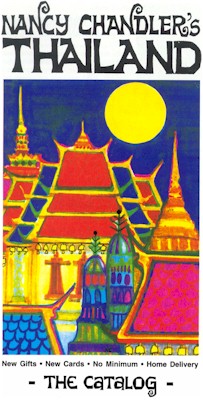 |
Her
second daughter, Siri, is probably the first International School of Bangkok (ISB)
graduate who has returned
as a
full-time overseas hire. She teaches kindergarten at the school. Before that,
she spent quite a few years at the
Early
Learning Center, and then she helped to set up the kindergarten at International
School of the Eastern
Seaboard (ISE), before accepting a job in Cochabamba, Bolivia. But during her year there,
she'd traveled most of
South
America and realized she missed Thailand, causing her to jump on a plane to head
back home to Thailand.
At 62,
Nancy shows no signs of letting up and her Bangkok based company is in Nima's oh
so capable hands. She
probably
owes a lot of her inspiration to her father, Maurice Sands, who was a prominent
architect and interior
designer
in San Francisco. But whatever Nancy's motivation, her maps have helped so many
people make sense of
the
chaos of Bangkok and Chiang Mai's crowded streets and sois.
And
just so we don't forget Al, one of his tasks was that through his firm, Chandler
and Thong-ek , he spent twenty
years
working for the Nepalese government, writing their petroleum law in an attempt
to attract international oil
companies
to drill through the Himalayas looking for oil (that’s what paid for Nima’s
university education.)
Wrapping
up, it’s obvious that the Chandlers are, by any yardstick you would care to
use, quite an accomplished
and
artistic family. And don't leave home without a Chandler.
Contact
Info:
NCG
Marketing Co., Ltd.
Bubhajit
Building, 8th Floor
20
North Sathorn Rd
Bangkok,
10500
Tel/Fax:
(662) 266-6579
E-Mail:
nancychandler@yahoo.com
Website:www.nancychandler.net
Finis





